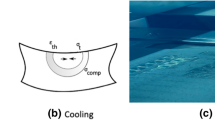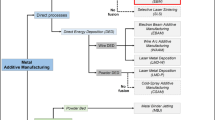Abstract
The additive manufacturing (AM) of laser powder bed fusion (LPBF) manufactures three-dimensional products by melting metal powders using laser energy and staking repeatedly the fabricated layers. However, residual stress generated by the heat gradient presents a technical challenge for the application of metal AM in commercial products, as excessive residual stress can cause thermal deformation, cracks, and delamination in the products. In this study, the numerical thermal analysis of a smartphone camera housing was performed for various design geometries by applying the inherent strain method. The optimization of the design geometry relieved the maximum deformation by 8.2 %. The simulation results showed excellent agreement with the measured deformation based on the maximum deformation. The method of minimizing thermal deformation and optimizing design geometry was explained in great detail. This demonstrates the possibility of the application of the LPBF technique in practical engineering fields, including mobile phones.
Similar content being viewed by others
Abbreviations
- P :
-
Laser power
- v :
-
Scan speed
- d :
-
Line spacing
- t :
-
Layer thickness
- VED:
-
Volumetric energy density
- ε :
-
Residual total strain
- ε e :
-
Elastic strain
- ε p :
-
Plastic strain
- ε thermal :
-
Thermal strain
- ε phase :
-
Phase transition induced strain
- ε* :
-
Inherent strain
- K :
-
Elastic stiffness matrix
- u :
-
Displacement
- f* :
-
Inherent strain induced force
- σ :
-
Residual stress
- B :
-
Corresponding matrix between the nodal displacement and strains in an element
- D e :
-
Material elastic matrix
References
M. Chiumenti, E. Neiva, E. Salsi, M. Cervera, S. Badia, J. Moya, Z. Chen, C. Lee and C. Davies, Numerical modelling and experimental validation in selective laser melting, Additive Manufacturing, 18 (2017) 171–185.
S. M. Yusuf and N. Gao, Influence of energy density on metallurgy and properties in metal additive manufacturing, Materials Science and Technology, 33(11) (2017) 1269–1289.
J. H. Bae, J. M. Yu, V. H. Dao, V. Lok and K. B. Yoon, Effects of processing parameters on creep behavior of 316L stainless steel produced using selective laser melting, Journal of Mechanical Science and Technology, 35 (2021) 3803–3812.
R. J. Williams, C. M. Davies and P. A. Hooper, A pragmatic part scale model for residual stress and distortion prediction in powder bed fusion, Additive Manufacturing, 22 (2018) 416–425.
H. T. Tran, X. Liang and A. C. To, Efficient prediction of cracking at solid-lattice support interface during laser powder bed fusion via global-local J-integral analysis based on modified inherent strain method and lattice support homogenization, Additive Manufacturing, 36 (2020) 101590.
Q. Chen, X. Liang, D. Hayduke, J. Liu, L. Cheng, J. Oskin, R. Whitmore and A. C. To, An inherent strain based multiscale modeling framework for simulating part-scale residual deformation for direct metal laser sintering, Additive Manufacturing, 28 (2019) 406–418.
T. Mukherjee, W. Zhang and T. DebRoy, An improved prediction of residual stresses and distortion in additive manufacturing, Computational Materials Science, 126 (2017) 360–372.
B. Ahmad, S. O. van der Veen, M. E. Fitzpatrick and H. Guo, Residual stress evaluation in selective-laser-melting additively manufactured titanium (Ti-6Al-4V) and inconel 718 using the contour method and numerical simulation, Additive Manufacturing, 22 (2018) 571–582.
Y. Yang, Y. Gong, S. Qu, B. Xin, Y. Xu and Y. Qi, Additive/subtractive hybrid manufacturing of 316L stainless steel powder: densification, microhardness and residual stress, Journal of Mechanical Science and Technology, 33 (2019) 5797–5807.
B. Bagheri, M. Abbasi and R. Hamzeloo, The investigation into vibration effect on microstructure and mechanical characteristics of friction stir spot vibration welded aluminum: simulation and experiment, Proceedings of the Institution of Mechanical Engineers, Pat C: Journal of Mechanical Engineering Science, 234 (2020) 1809–1822.
Namu.kiki, LG V40 ThinQ, https://namu.wiki/w/LG%20V40%20ThinQ.
M. Abbasi, A. Abdollahzadeh, B. Bagheri, A. O. Moghaddam, F. Sharifi and M. Dadaei, Study on the effect of the welding environment on the dynamic recrystallization phenomenon and residual stresses during the friction stir welding process of aluminum alloy, Proceedings of the Institution of Mechanical Engineers, Pat L: Journal of Materials: Design and Applications, 235 (2021) 1809–1826.
C. Wu, C. Lee and J.-W. Kim, Numerical simulation of bending deformation induced by multi-seam welding of a steel-pipe structure, Journal of Mechanical Science and Technology, 34 (2020) 2121–2131.
J. H. Martin, B. D. Yahata, J. M. Hundley, J. A. Mayer, T. A. Schaedler and T. M. Pollock, 3D printing of high-strength aluminium alloys, Nature, 549(7672) (2017) 365–369.
A. Takezawa, A. C. To, Q. Chen, X. Liang, F. Dugast, X. Zhang and M. Kitamura, Sensitivity analysis and lattice density optimization for sequential inherent strain method used in additive manufacturing process, Computer Methods in Applied Mechanics and Engineering, 370 (2020) 113231.
N. Ma, K. Nakacho, T. Ohta, N. Ogawa and A. Maekawa, Inherent strain method for residual stress measurement and welding distortion prediction, Proceedings of the ASME 2016 35th International Conference on Ocean, Offshore and Arctic Engineering (2016).
MSC Software Company, Tutorial Simufact Additive (2018) 63–65.
I. Setien, M. Chiumenti, S. van der Veen, M. S. Sebastian, F. Garciandia and A. Echeverria, Empirical methodology to determine inherent strains in additive manufacturing, Computers and Mathematics with Applications, 78 (2019) 2282–2295.
M. Bugatti and Q. Semeraro, Limitations of the inherent strain method in simulating powder bed fusion processes, Additive Manufacturing, 23 (2018) 329–346.
L. Cheng, X. Liang, J. Bai, Q. Chen, J. Lemon and A. To, On utilizing topology optimization to design support structure to prevent residual stress induced build failure in laser powder bed metal additive manufacturing, Additive Manufacturing, 27 (2019) 290–304.
Z.-D. Zhang, O. Ibhadode, U. Ali, C. F. Dibia, P. Rahnama, A. Bonakdar and E. Toyserkani, Topology optimization parallelcomputing framework based on the inherent strain method for support structure design in laser powder-bed fusion additive manufacturing, International Journal of Mechanics and Materials in Design, 16 (2020) 897–923.
M. Seabra, J. Azevedo, A. Araujo, L. Reis, E. Pinto, N. Alves, R. Santos and J. P. Mortagua, Selective laser melting (SLM) and topology optimization for lighter aerospace componentes, Procedia Structural Integrity, 1 (2016) 289–296.
K.-T. Yang, M.-K. Kim, D. Kim and J. Suhr, Investigation of laser powder bed fusion manufacturing and post-processing for surface quality of as-built 17-4PH stainless steel, Surface and Coatings Technology, 422 (2021) 127492.
F. Chu, K. Zhang, H. Shen, M. Liu, W. Huang, X. Zhang, E. Liang, Z. Zhou, Li. Lei, J. Hou and A. Huang, Influence of satellite and agglomeration of powder on the processability of AlSi10Mg powder in laser powder bed fusion, Journal of Materials Research and Technology, 11 (2021) 2059–2073.
S. Tammas-Williams, P. J. Withers and I. Todd, The influence of porosity on fatigue crack initiation in additively manufactured titanium components, Scientific Reports, 7 (2017) 7308.
S.-M. Itziar, T. Fritsch, T. Mishurova, A. Trofimov and D. Apel, On the interplay of microstructure and residual stress in LPBF IN718, Journal of Materials Science, 56 (2021) 5845–5867.
A. J. Dunbar, E. R. Denlinger, M. F. Gouge and P. Michaleris, Experimental validation of finite element modeling for laser powderbed fusion deformation, Additive Manufacturing, 12 (2016) 108–120.
U. S. Kim and J. W. Park, High-quality surface finishing of industrial three-dimensional metal additive manufacturing using electrochemical polishing, International Journal of Precision Engineering and Manufacturing-Green Technology, 6 (2019) 11–21.
Acknowledgments
This work was supported by LG Electronics Inc., the Technology Innovation Program (20013794, Center for Composite Materials and Concurrent Design) funded by the Ministry of Trade, Industry & Energy (MOTIE, KOREA), the Korea Agency for Infrastructure Technology Advancement (KAIA) grant funded by the Ministry of Land, Infrastructure and Transport (Grant 20CTAP-C157950-01), and KOREA HYDRO & NUCLEAR POWER CO., LTD.
Author information
Authors and Affiliations
Corresponding author
Additional information
Kyung-Tae Yang is a Ph.D. candidate in the Department of Mechanical Engineering at Sungkyunkwan University, Suwon, Korea. He works for LG Electronics as a Chief Research Engineer for the development of smartphones and innovative design devices. His research interests include additive manufacturing and the commercialization of metal 3D printing technology.
Min-Kyeom Kim is a Ph.D. candidate in the Department of Mechanical Engineering at Sungkyunkwan University, Suwon, Korea. His research area is the process design of metal 3D printing, focusing on laser powder bed fusion and wire arc additive manufacturing.
Taehwan Kim is an M.S. student in the Department of Mechanical Engineering at Sungkyunkwan University, Suwon, Korea. His interests include overall 3D printing technologies. He is studying the thermo-mechanical simulation and design of support structures to minimize residual stress and increase the printing quality of metal additive manufacturing.
Jonghwan Shur is an Associate Professor in the Department of Mechanical Engineering at Sungkyunkwan University, Suwon, Korea. He received a Ph.D. in mechanical engineering from Rensselaer Polytechnic Institute, USA in 2005. His research interests include materials design; synthesis and characterization; structural analysis and design; lightweight energy-absorbing composites; and environment-friendly composites.
Rights and permissions
About this article
Cite this article
Yang, KT., Kim, MK., Kim, T. et al. Design optimization of smartphone camera housing fabricated by laser powder bed fusion using thermal analysis. J Mech Sci Technol 36, 699–708 (2022). https://doi.org/10.1007/s12206-022-0118-6
Received:
Revised:
Accepted:
Published:
Issue Date:
DOI: https://doi.org/10.1007/s12206-022-0118-6




